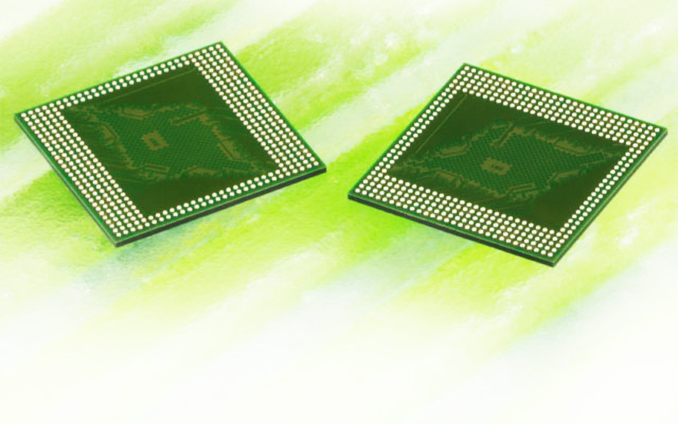Micron Kicks Off Mass Production of 12 Gb LPDDR4X DRAM Chips
by Anton Shilov on November 8, 2018 11:00 AM EST
Micron this week announced that it had started mass production of its first LPDDR4X memory devices using its second-generation 10 nm-class process technology. The new memory devices offer standard LPDDR4X data transfer rates of up to 4.266 Gbps per pin and consumes less power than earlier LPDDR4 chips.
Micron’s LPDDR4X devices are made using the company’s 1Y-nm fabrication tech and feature a 12 Gb capacity. The manufacturer says that its LPDDR4X memory chips consume 10% less power when compared to its LPDDR4-4266 products; this is because they feature a lower output driver voltage (I/O VDDQ), which the LPDDR4X standard reduces by 45%, from 1.1 V to 0.6 V.
Micron’s 12 Gb (1.5 GB) LPDDR4X devices feature a slightly lower capacity than competing 16 Gb (2 GB) LPDDR4X offerings, but they are also cheaper to manufacture. As a result, Micron can offer lower-cost quad-die 64-bit LPDDR4X-4266 packages with a 48 Gb (6 GB) capacity and a 34.1 GB/s bandwidth than some of its competitors.
The 12 Gb LPDDR4X DRAM is Micron’s first product to be manufactured using the company’s second-generation 10 nm-class process technology, so expect Micron to launch more DRAMs that are made using the same tech and therefore feature lower power consumption and higher frequency potential when compared to existing products.
Like other makers of DRAM, Micron usually does not announce products before it ships the first batch. Therefore, at least one customer of Micron may have already received its LPDDR4X DRAM devices.
Related Reading:
- Samsung Starts Production of 16 Gb LPDDR4X Chips Using 2nd Gen 10nm Tech
- SK Hynix Announces 8 GB LPDDR4X-4266 DRAM Packages
- SK Hynix Updates Lineup: 8 GB LPDDR4 DRAM Packages for Mobile Devices
Source: Micron










10 Comments
View All Comments
iwod - Thursday, November 8, 2018 - link
Sounds exactly like the chip being used in the current iPad Pro 1TB.neblogai - Thursday, November 8, 2018 - link
Maybe it is not it's intended market.. But a ~Raven Ridge at 7nm, with 12GB of this RAM would have very respectable 68GB/s bandwidth, and would be perfect for highend ultra-portable with gaming capability.wizfactor - Thursday, November 8, 2018 - link
I have an unhealthy obsession with the prowess of non-discrete graphics, so any affordable memory technology that can speed up iGPUs is automatically exciting to me.ImSpartacus - Friday, November 9, 2018 - link
Yeah, that'd be pretty nice for a hyper-integrated machine, like a Surface Pro-esque tablet or something.wizfactor - Thursday, November 8, 2018 - link
Every time I hear news about LPDDR4/X, it always sounds to me like it has more bandwidth at 128-bit than standard DDR4 has when running in dual-channel.Wikipedia states that DDR4-3200 only has a single-channel bandwidth of 25.6 GB/s, which when doubled still falls behind this LPDDR4X chip when used in a 128-bit configuration. If this is true, how could LPDDR4/X, which operates at a lower voltage than DDR4, accomplish this?
StevoLincolnite - Thursday, November 8, 2018 - link
It doesn't. LPDDR4X is operating at 4266Mhz rather than 3200mhz.Meaning it would offer 68.2GB/s of bandwidth on a 128-bit bus... Where-as at 3200mhz you are looking at 51.2GB/s on a 128bit bus.
wizfactor - Thursday, November 8, 2018 - link
Oh I see, so I've been making the incorrect comparison this whole time. That means DDR4-3200 and LPDDR4 should have the same bandwidth, right?If that's the case, is there any reason why any PC manufacturer would choose regular DDR4 over its low-power variant? Price? Latency?
Lolimaster - Friday, November 9, 2018 - link
Maybe it's similar to GDDR, faster bw but loose timmings and slow performance, not much important for a smartphone.FreidoNumeroUno - Sunday, November 11, 2018 - link
I have the same question. Can someone help with a clearer answer?anonym - Tuesday, November 13, 2018 - link
Use different core and I/O voltage.